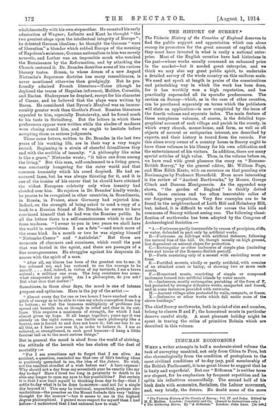THE HISTORY OF SURREY.* The Victoria History of the Counties
of England deserves to find the public support and appreciation which can alone recoup its promoters for the great amount of capital which they must have invested in what is really a national enter- prise. Most of the English counties have had historians in the past—whose works usually command an enhanced price in the market—but it needed great enterprise, and we think we may also say great public spirit, to undertake a detailed survey of the whole country on this uniform scale. We need not speak at length in praise of the conscientious and painstaking way in which the work has been done, for it has worthily won a high reputation, and has practically superseded all its sporadic predecessors. The section on Surrey—which, as in the case of other counties, can be purchased separately on terms which the publishers will state on application—is now completed by the issue of the fourth volume and separate index. The main feature of these sumptuous volumes, of course, is the detailed topo- graphical account of each village and parish in the county, in which every church, manor-house, and farm, as well as all objects of natural or antiquarian interest, are described by experts, and their history is traced from the records. For this alone every owner of a country house in Surrey ought to have these volumes in his library for his own edification and the entertainment of his visitors. In addition, there are many special articles of high value. Thus, in the volume before us, we have read with great pleasure the essay on " Romano- British Surrey," by the general editor, Mr. William Page, and Miss Edith Keate, with an excursus on that puzzling site Noviomagus by Professor Haverfield. Even more interesting is the review of "Ancient Earthworks," by Messrs. George Clinch and Duncan Montgomerie. As the appended map shows, " the garden of England " is thickly dotted with these curious and too often inscrutable relics of our forgotten progenitors. "Very fine examples are to be found in the neighbourhood of Leith Hill and Holmbury Hill, but, indeed, it is difficult to walk far across the hills and commons of Surrey without seeing one. The following classi- fication of earthworks has been adopted by the Congress of Archaeological Societies :—
" A.—Fortresses partly inaccessible by reason of precipices, cliffs, or water, defended in part only by artificial works.
B.—Fortresses on hill-tops with artificial defences, following the natural line of the hill. Or, though usually on high ground, less dependent on natural slopes for protection.
C.—Rectangular or other inclosures of simple plan (including forts and towns of the Romano-British period).
D.—Forts consisting only of a mount with encircling moat or fosse.
E.—Fortified mounts, wholly or partly artificial, with remains of an attached court or bailey, or showing two or more such courts.
F.—Homestead moats, consisting of simple or compound inclosures formed into artificial islands by water moats.
G.—Inclosures, mostly rectangular, partaking of the form of F, but protected by stronger defensive works, ramparted and tossed, and in some instances provided with outworks.
H.—Ancient village sites protected by walls, ramparts, or fosses. X.—Defensive or other works which fall under none of the above headings."
The chief Surrey earthworks, both in point of size and number, belong to classes B and F ; the homestead moats in particular deserve careful study. A most pleasant holiday might be spent in tracing the relics of primitive Britain which are described in this volume.


































 Previous page
Previous page